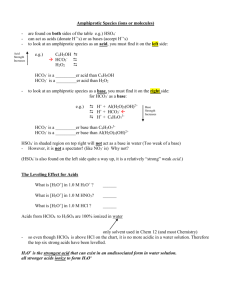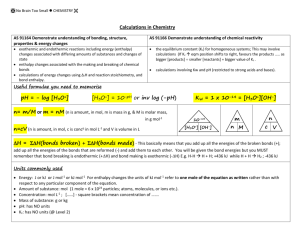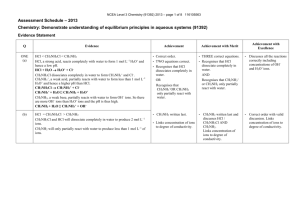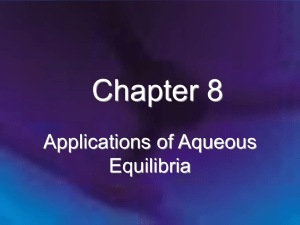Answer key to Problem Set on Chapters 16 and 17
advertisement
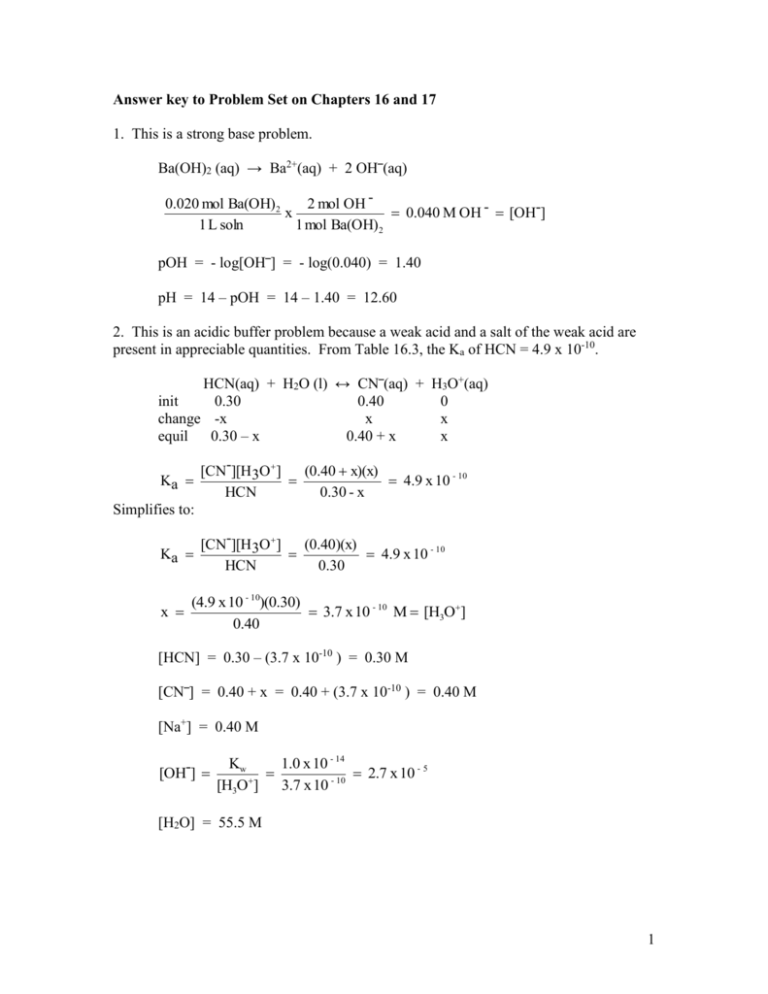
Answer key to Problem Set on Chapters 16 and 17 1. This is a strong base problem. Ba(OH)2 (aq) → Ba2+(aq) + 2 OH‾(aq) 0.020 mol Ba(OH) 2 2 mol OH x 0.040 M OH - [OH-] 1 L soln 1 mol Ba(OH) 2 pOH = - log[OH‾] = - log(0.040) = 1.40 pH = 14 – pOH = 14 – 1.40 = 12.60 2. This is an acidic buffer problem because a weak acid and a salt of the weak acid are present in appreciable quantities. From Table 16.3, the Ka of HCN = 4.9 x 10-10. HCN(aq) + H2O (l) ↔ CN‾(aq) + H3O+(aq) init 0.30 0.40 0 change -x x x equil 0.30 – x 0.40 + x x Ka [CN-][H3O ] (0.40 x)(x) 4.9 x 10 - 10 HCN 0.30 - x Simplifies to: Ka x [CN-][H3O ] (0.40)(x) 4.9 x 10 - 10 HCN 0.30 (4.9 x 10 - 10)(0.30) 3.7 x 10 - 10 M [H3O] 0.40 [HCN] = 0.30 – (3.7 x 10-10 ) = 0.30 M [CN‾] = 0.40 + x = 0.40 + (3.7 x 10-10 ) = 0.40 M [Na+] = 0.40 M [OH-] Kw 1.0 x 10 - 14 2.7 x 10 - 5 - 10 [H3O ] 3.7 x 10 [H2O] = 55.5 M 1 3. This is a strong acid problem. HNO3(aq) + H2O(l) ↔ NO3‾(aq) + H3O+(aq) [HNO3] = 0 M [NO3‾] = [H3O+] = 0.45 M [H2O] = 55.5 M [OH-] Kw 1.0 x 10 - 14 2.2 x 10 - 14 M [H3O] 0.45 4. This is a weak acid problem. The Ka of HNO2 is 4.5 x 10-4. HNO2(aq) + H2O(l) → NO2‾(aq) + H3O+(aq) init 0.45 0 0 change -x +x +x equil. 0.45 – x x x Ka [NO2-][H3O ] (x)(x) 4.5 x 10 - 4 [HNO2] 0.45 x Simplifies to: Ka [NO2-][H3O ] (x)(x) 4.5 x 10 - 4 [HNO2] 0.45 x2 = 4.5 x 10-4(0.45) = 2.0 x 10-4 x 2.0 x 10 - 4 1.4 x 10 - 2 M [H3O] [NO2-] [HNO2] = 0.45 – x = 0.45 – 1.4 x 10-2 = 0.44 M [OH-] Kw 1.0 x 10 - 14 7.1 x 10 - 13 M -2 [H3O ] 1.4 x 10 [H2O] = 55.5 M 2 5. This is a hydrolysis problem. The salt is the salt of a strong acid and strong base, so neither Na+ (weak conjugate acid) nor NO3‾ (weak conjugate base) will hydrolyze. Both these ions are spectator ions. Thus, the only [H3O+] or [OH‾] is from the dissociation of water. [Na+] = [NO3‾] = 0.45 M [H3O+] = [OH‾] = 1.0 x 10-7 M [H2O] = 55.5 M 6. This is also a hydrolysis problem. The K+ is a spectator because it is the weak conjugate acid of a strong base. Nitrite ion will hydrolyze: NO2‾(aq) + H2O(l) ↔ HNO2(aq) + OH‾(aq) 0.45 0 0 -x x x 0.45 – x x x init change equil Need to find Kb: Kb Kb Kw 1.0 x 10 - 14 2.2 x 10 - 11 Ka 4.5 x 10 - 4 [HNO2][OH-] (x)(x) 2.2 x 10 - 11 [NO2 ] 0.45 x Simplifies to: Kb [HNO2][OH-] (x)(x) 2.2 x 10 - 11 [NO2 ] 0.45 x2 = 2.2 x 10-11(0.45) = 1.0 x 10-11 x 1.0 x 10 - 11 3.2 x 10 - 6 M [HNO2] [OH-] [NO2ˉ] = 0.45 – x = 0.45 – (3.2 x 10-6) = 0.45 M [K+] = 0.45 M [H2O] = 55.5 M 3 7. This is a weak base problem. The Kb for CH3NH2 is found on Table 16.5 and has a value of 4.4 x 10-4. CH3NH2 (aq) + H2O(l) ↔ CH3NH3+ (aq) + OHˉ(aq) init. 0.35 0 0 change -x x x equil. 0.35 – x x x Kb [CH3NH3 ][OH-] (x)(x) 4.4 x 10 - 4 CH3NH2 0.35 x Simplifies to: [CH3NH3 ][OH-] (x)(x) Kb 4.4 x 10 - 4 CH3NH2 0.35 x2 = 4.4 x 10-4(0.35) = 1.5 x 10-4 x 1.5 x 10 -4 0.012 M [CH3NH3] [OH-] [CH3NH2] = 0.35 – x = 0.35 – 0.012 = 0.34 M [H3O] - 14 Kw 1 x 10 [OH ] 0.012 8.1 x 10 - 13 M [H2O] = 55.5 M 8. This is an alkaline buffer problem. CH3NH2 (aq) + H2O(l) ↔ CH3NH3+ (aq) + OHˉ(aq) init. 0.45 0.30 0 change -x x x equil. 0.45 – x 0.30 + x x [CH3NH3 ][OH-] (0.30 x)(x) Kb 4.4 x 10 - 4 CH3NH2 0.45 x Simplifies to: Kb [CH3NH3 ][OH-] (0.30)(x) 4.4 x 10 - 4 CH3NH2 0.45 4 (4.4 x 10 - 4)(0.45) x 6.6 x 10 - 4 M [OH-] 0.30 [CH3NH3+] = 0.30 + x = 0.30 - 6.6 x 10-4 = 0.30 M [CH3NH2] = 0.45 – x = 0.45 - 6.6 x 10-4 = 0.45 M [H3O] - 14 Kw 1 x 10 1.5 x 10 - 11 M [OH ] 6.6 x 10 - 4 9. This is a solubility equilibrium problem. The Ksp of Cr(OH)3 is found on Table 17.2 and has a value of 3.0 x 10-29. equil. Cr(OH)3 (s) ↔ Cr3+ (aq) + 3 OHˉ(aq) x 3x Ksp = [Cr3+][OHˉ]3 = (x)(3x)3 = 3.0 x 10-29 27x4 = 3.0 x 10-29 x4 3.0 x 10 - 29 1.1 x 10 - 30 27 molar solubility x 4 1.1 x 10 - 30 3.2 x 10 - 8 10. This is a solubility problem which introduces a common ion. The Ksp of BaSO4 is found on Table 17.2 and has a value of 1.1 x 10-10 BaSO4(s) ↔ Ba2+(aq) + SO42- (aq) init 0 0.0050 change x +x equil. x 0.0050 + x Ksp = [Ba2+][SO42-] = (x)(0.0050 + x) = 1.1 x 10-10 Simplifies to: Ksp = [Ba2+][SO42-] = (x)(0.0050) = 1.1 x 10-10 [Ba2 ] Ksp 1.1 x 10 - 10 2.2 x 10 - 8 M 0.0050 0.0050 5 11. Here you need to find the reaction quotient, Q, and compare it to the Ksp. Find the new molarity of calcium ions and carbonate ions: [Ca2 ] [CO32-] (200 mL)(0.0040 M) 1.3 x 10 - 3 M Ca2 600 mL (400 mL)(0.0003 3 M CO32-) 2.2 x 10 - 4 M CO32 600 mL Calculate the reaction quotient, Q: Q = [Ca2+][ CO32- ] = (1.3 x 10-3 )(2.2 x 10-4) = 2.9 x 10-7 Compare Q and Ksp for calcium carbonate. The Ksp of CaCO3 is 8.7 x 10-9. 2.9 x 10-7 > 8.7 x 10-9. Q > Ksp Since Q > Ksp , the solubility has been exceeded (equilibrium is too far to the right), so a precipitate will form. 12. This is a complex ion equilibrium problem. Calculate the moles of Cu2+ and moles of CN ˉ: mol Cu2+ = (0.100 L )(0.10 mol Cu2+/L) = 0.010 mol Cu2+ mol CN ˉ = (0.100 L)(0.50 mol CN ˉ/L) = 0.050 mol CN ˉ Cu2+(aq) + 4 CNˉ(aq) ↔ Cu(CN)42-(aq) init 0.010 mol 0.050 mol 0 mol change - 0.010 mol - 0.040 mol 0.010 mol Notice that 0.010 mol of CN ˉ remains in excess. The new concentration of CN ˉ will be: 0.010 mol CN [CN-] 0.10 M CN 0.100 L soln The concentration of complex ion, Cu(CN)42- produced in solution is: Cu(CN)42 - 0.010 mol Cu(CN)42 0.10 M Cu(CN)42 0.100 L 6 Using the equilibrium expression: init change equil. Cu2+(aq) + 4 CNˉ(aq) ↔ Cu(CN)42-(aq) 0 0.10 0.10 +x + 4x -x x 0.10 + 4x 0.10 – x [Cu(CN)42-] Kf 1.0 x 1025 2 4 [Cu ][CN ] Kf 0.10 x 1.0 x 1025 4 (x)(0.10 4x) Kf 0.10 1.0 x 1025 4 (x)(0.10) (from Table 17.4) Simplifies to: x 0.10 1.0 x 1022 M [Cu2 ] 25 4 (0.10) (1.0 x 10 ) 7

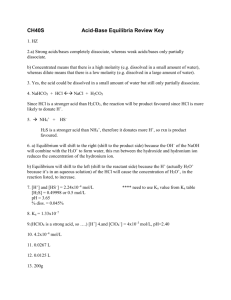
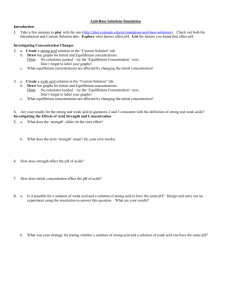



![CHEM 1520 SI MON, TUES, & WEDNES 1.Calculate [H3O+] in a](http://s3.studylib.net/store/data/007346334_1-b78d73402f58153c92290299886ff084-300x300.png)
